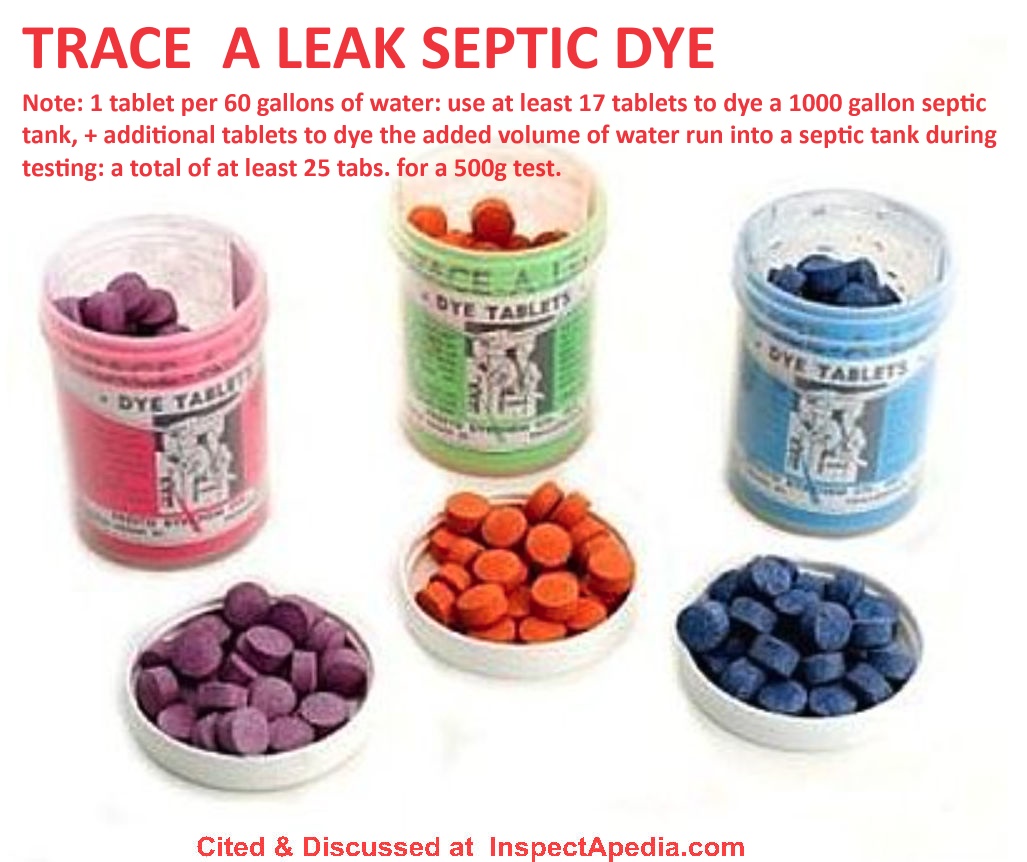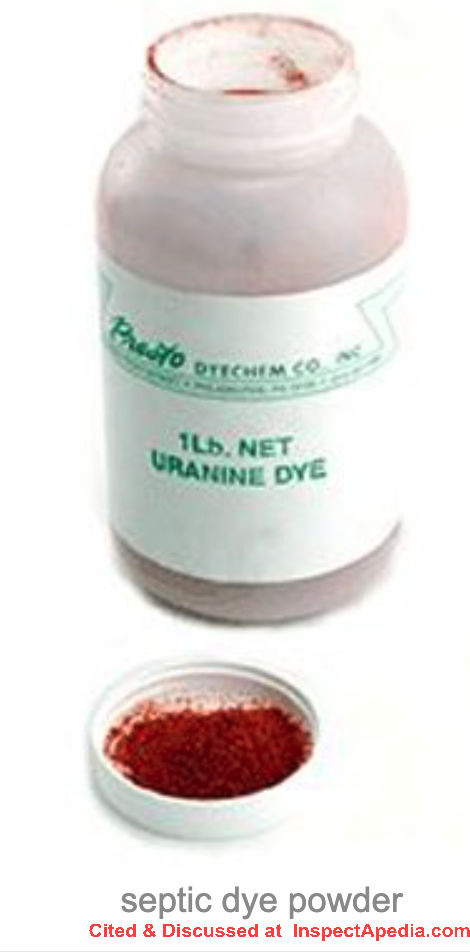 Septic Dye Sources & SDS
Septic Dye Sources & SDS
Where to buy dye for a septic test
Septic dye SDS, MSDS, TDS sheets
Septic dye safety
- POST a QUESTION or COMMENT about mistakes or even catastrophes that might occur or might be detected during a septic inspection & dye test
Here we give sources & manufacturers of septic test dye products along with links to the safety data sheets or MSDS or technical data sheets for dyes used in septic testing.
Page top photo: examples of septic test dye in three colors in tablet form - discussed below.
InspectAPedia tolerates no conflicts of interest. We have no relationship with advertisers, products, or services discussed at this website.
- Daniel Friedman, Publisher/Editor/Author - See WHO ARE WE?
Septic Dye Sources, Safety, MSDS
 Used as directed, the septic dye itself is considered a safe product, though above on this page we include a number of other practical and safety warnings for people conducting a septic test or using tracer dyes.
Used as directed, the septic dye itself is considered a safe product, though above on this page we include a number of other practical and safety warnings for people conducting a septic test or using tracer dyes.
Here are example SDS (Safety Data Sheets) and TDS (Technical Data Sheets) for septic tracer dye products.
Illustration: Presto Dyechem Company's red fluorescent septic dye in liquid form, cited below.
The detailed steps in proper use of septic dye for testing a septic system are
at SEPTIC LOADING & DYE TEST PROCEDURE - home
- Bright Dyes Inc. source of septic system testing tracer dyes, Website: http://www.brightdyes.com/products/dyetracers.html
- Norlab, RED SEPTIC DYE SAFETY DATA SHEET [SDS] [PDF] Norlab Inc., 7465 Industrial Parkway, Lorain, Ohio USA 44053 (P) 440-282-5265
Excerpts:
2 Hazards identification
- Classification of the substance or mixture: The product is not classified according to the Globally Harmonized System (GHS)
-
Environmental precautions: Material is approved for controlled release for certain water tracing applications.
Refer to any and all state or municipal regulations to determine trace study requirements.
- Methods and material for containment and cleaning up: Clean the affected area carefully; suitable cleaners are: warm water
- Reference to other sections
No dangerous substances are released.
See Section 7 for information on safe handling.
See Section 8 for information on personal protection equipment.
See Section 13 for disposal information.
Exposure controls
- Personal protective equipment:
General protective and hygienic measures: Product is a concentrated colorant and can stain skin and/or various articles. The hazards of this product should be low under normal industrial and commercial use. - Norlab, RED SEPTIC DYE TECHNICAL DATA SHEET - TDS [PDF] Norlab, Inc., (Op. Cit.)
- Pollard Water source of septic system testing tracer dyes, Website: http://www.pollardwater.com/emarket/Pages/dyesdata.asp

Illustrated above: Presto Dyechem's uranine septic dye powder. \
- Presto Dyechem, TRACE A LEAK RED LIQUID SEPTIC DYE TEST MSDS [PDF] Water Dye Teting for Septic, Presto Dyechem Co., 60 North Front St., Philadelphia, PA 19106 USA Tel: 215-627-1864
Excerpt: Health Hazards - Acute and Chronic...... NONE DOCUMENTED - Presto Dyechem, TRACE A LEAK YELLOW-GREEN URANINE SEPTIC DYE MSDS [PDF] (Orange powder), Presto Dyechem Co., (Op. Cit.)
- Pylam Pyla-Tel Fluorescent green septic dye test dye powder, Pylam Products Company, Inc. 2175 East Cedar Street Tempe, Arizona 85281-7431. Phone: 480-929-0070 800-645-6096. Fax: 480-929-0078. Emails: sales@pylamdyes.com www.pylamdyes.com/contact.html Website: http://www.pylamdyes.com/index.html
- Pylam Pyla-Tel Fluorescent red septic dye test dye powder
- Septic dye test powder may be packaged and re-sold by local plumbing or chemical suppliers in in your area. For example, we bought repackaged septic dye powder from Duso Chemical in Poughkeepsie NY
- Trace A Leak dye tablets - watch out to be sure you use enough for a valid septic test -
see SEPTIC TEST VOLUMES & DYE AMOUNTS - Trace A Leak liquid septic dye (fluorescent yellow.green) - Tool Experts - http://www.toolexperts.com/
- Tramfloc, Inc. source of septic system testing tracer dyes, Website: http://www.tramfloc.com/tf74.html
- Material Safety Data Sheet MSDS for Red Septic Dye [PDF] from Tramfloc.
- MSDS for Septic Dye Tablets [PDF] from Tramfloc.
- MSDS for Septic Dye Liquid [PDF]from Tramfloc.
- Septic Dye Technical Data Bulletin [PDF]from Tramfloc.
- Septic Dye MSDS [Web page] material safety data sheets for septic dye powder and tablet products
- Septic, Cesspool Yellow Fluorescent tracer dye (powder) - http://www.professionalequipment.com home inspection supplier
Photo above: green septic dye being flushed into a toilet by the author.
Related Research:
Related dyes are used in some medical applications, as you can see in this reference:
- Parish, Christopher R., Megan H. Glidden, Ben JC Quah, and Hilary S. Warren. "Use of the intracellular fluorescent dye CFSE to monitor lymphocyte migration and proliferation." Current protocols in immunology 84, no. 1 (2009): 4-9.
Excerpt:
The stable incorporation of the intracellular fluorescent dye 5‐(and‐6)‐carboxyfluorescein diacetate succinimidyl ester (CFSE) into cells provides a powerful tool to monitor cell migration, and to quantify cell division, because of the sequential decrease in fluorescent labeling in daughter cells.
...
Continue reading at SEPTIC LOADING & DYE TEST PROCEDURE - home or select a topic from the closely-related articles below, or see the complete ARTICLE INDEX.
Or see these
Recommended Articles
Suggested citation for this web page
SEPTIC DYE SOURCES, SAFETY, TOXICITY, STAINING, MSDS at InspectApedia.com - online encyclopedia of building & environmental inspection, testing, diagnosis, repair, & problem prevention advice.
Or see this
INDEX to RELATED ARTICLES: ARTICLE INDEX to SEPTIC SYSTEMS
Or use the SEARCH BOX found below to Ask a Question or Search InspectApedia
Ask a Question or Search InspectApedia
Questions & answers or comments about mistakes or even catastrophes that might occur or might be detected during a septic inspection & dye test.
Try the search box just below, or if you prefer, post a question or comment in the Comments box below and we will respond promptly.
Search the InspectApedia website
Note: appearance of your Comment below may be delayed: if your comment contains an image, photograph, web link, or text that looks to the software as if it might be a web link, your posting will appear after it has been approved by a moderator. Apologies for the delay.
Only one image can be added per comment but you can post as many comments, and therefore images, as you like.
You will not receive a notification when a response to your question has been posted.
Please bookmark this page to make it easy for you to check back for our response.
IF above you see "Comment Form is loading comments..." then COMMENT BOX - countable.ca / bawkbox.com IS NOT WORKING.
In any case you are welcome to send an email directly to us at InspectApedia.com at editor@inspectApedia.com
We'll reply to you directly. Please help us help you by noting, in your email, the URL of the InspectApedia page where you wanted to comment.
Citations & References
In addition to any citations in the article above, a full list is available on request.
- New York State Department of Health, APPENDIX 75-A WASTEWATER TREATMENT STANDARDS - INDIVIDUAL HOUSEHOLD SYSTEMS , [PDF] New York State Department of Health, 3 February 2010, retrieved 3/1/2010, original source: https://www.health.ny.gov/regulations/nycrr/title_10/part_75/appendix_75-a.htm
- John Cranor [Website: /www.house-whisperer.com ] is an ASHI member and a home inspector (The House Whisperer) is located in Glen Allen, VA 23060. He is also a contributor to InspectApedia.com in several technical areas such as plumbing and appliances (dryer vents). Contact Mr. Cranor at 804-873-8534 or by Email: johncranor@verizon.net
- Pennsylvania State Wastewater Treatment Fact Sheet SW-161, Septic System Failure: Diagnosis and Treatment
- Pennsylvania State Wastewater Treatment Fact Sheet SW-162, The Soil Media and the Percolation Test
- Pennsylvania State Wastewater Treatment Fact Sheet SW-l64, Mound Systems for Wastewater Treatment
- Pennsylvania State Wastewater Treatment Fact Sheet SW-165, Septic Tank-Soil Absorption Systems
- Document Sources used for this web page include but are not limited to: Agricultural Fact Sheet #SW-161 "Septic Tank Pumping," by Paul D. Robillard and Kelli S. Martin. Penn State College of Agriculture - Cooperative Extension, edited and annotated by Dan Friedman (Thanks: to Bob Mackey for proofreading the original source material.)
- Septic System Owner's Manual, Lloyd Kahn, Blair Allen, Julie Jones, Shelter Publications, 2000 $14.95 U.S. - easy to understand, well illustrated, one of the best practical references around on septic design basics including some advanced systems; a little short on safety and maintenance.
- US EPA ONSITE WASTEWATER TREATMENT SYSTEMS MANUAL Top Reference: US EPA's Design Manual for Onsite Wastewater Treatment and Disposal, 1980, available from the US EPA, the US GPO Superintendent of Documents (Pueblo CO), and from the National Small Flows Clearinghouse. Original source http://www.epa.gov/ORD/NRMRL/Pubs/625R00008/625R00008.htm
- Water Wells and Septic Systems Handbook, R. Dodge Woodson. This book is in the upper price range, but is worth the cost for serious septic installers and designers.
- In addition to citations & references found in this article, see the research citations given at the end of the related articles found at our suggested
CONTINUE READING or RECOMMENDED ARTICLES.
- Carson, Dunlop & Associates Ltd., 120 Carlton Street Suite 407, Toronto ON M5A 4K2. Tel: (416) 964-9415 1-800-268-7070 Email: info@carsondunlop.com. Alan Carson is a past president of ASHI, the American Society of Home Inspectors.
Thanks to Alan Carson and Bob Dunlop, for permission for InspectAPedia to use text excerpts from The HOME REFERENCE BOOK - the Encyclopedia of Homes and to use illustrations from The ILLUSTRATED HOME .
Carson Dunlop Associates provides extensive home inspection education and report writing material. In gratitude we provide links to tsome Carson Dunlop Associates products and services.


